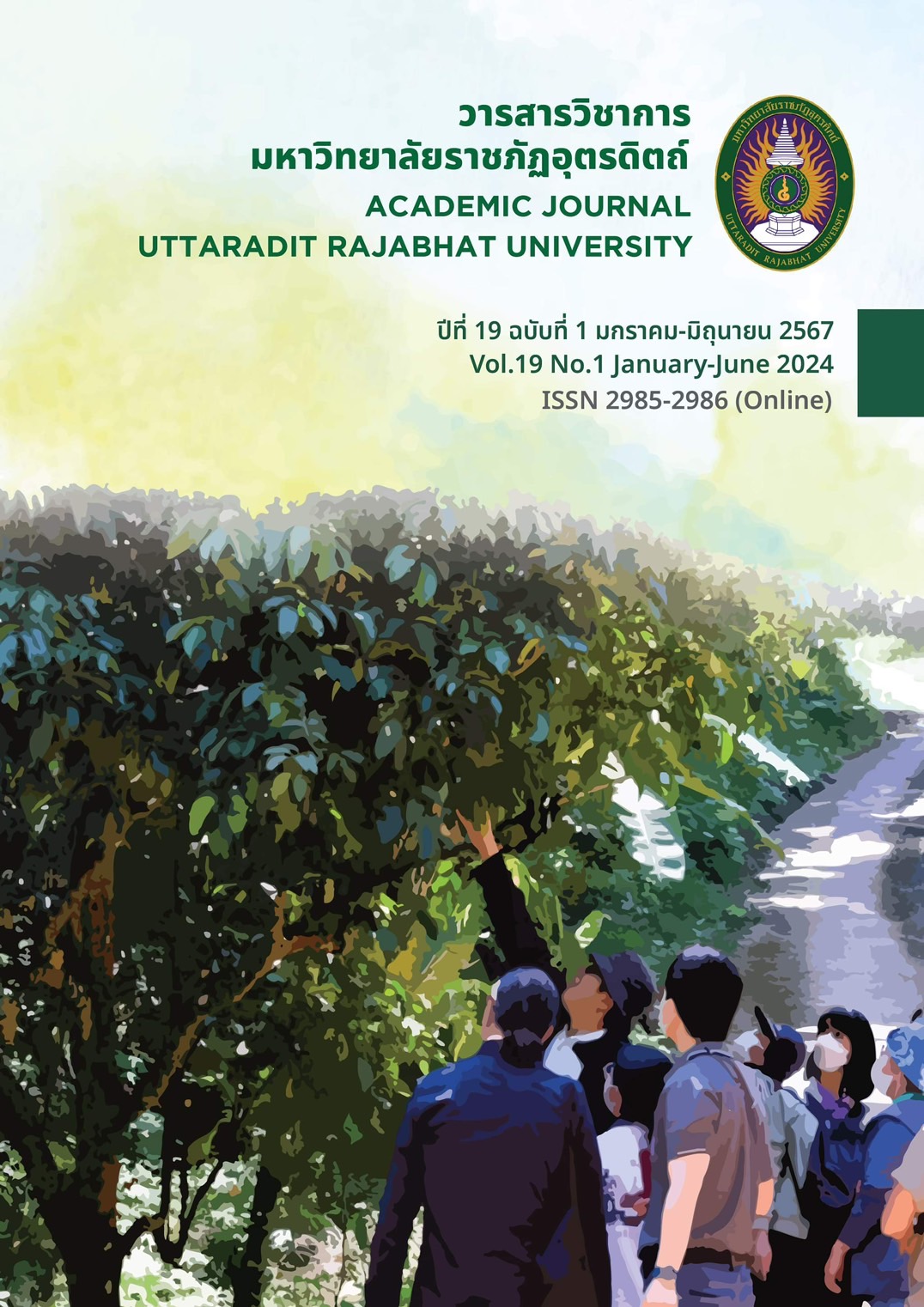DESIGN AND PERFORMANCE TESTING OF SOLAR ENERGY RICE MILLING MACHINE FOR COMMUNITY RICE MILL IN KROK PHRA DISTRICT OF NAKHON SAWAN PROVINCE
Main Article Content
Abstract
The objectives of this research were to design, test the efficiency, and perform an economic cost benefit analysis of a solar powered rice milling machine for the community’s rice mill in Krok Phra District of Nakhon Sawan Province. The research method was conducted to examine the problems of rice milling process, design the rice milling machine with the structure made of steel with the power source of electric motor of 1.5 HP. The main components of the machine consisted of rice pickup truck, rice polishing ball, rice polishing stone, screen sieve, rice husk suction vent with the transmission system installation of a solar power system of solar cell, inverter and battery. According to the testing for finding the efficiency of milling 3 varieties of rice at the appropriate speed of rotation, and the suitable distance of the rubber ball, it was found that the appropriate rice milling of RD 41 was at the speed of 1,290 rpm and the distance of 0.9 mm, that of Chainat 1 at the speed was 1,350 rpm and the distance was 0.9 mm, and that of Hom Pathum Thani at the speed was 1,200 rpm and the distance was 1.0 mm. The results of the testing on the suitable moisture of rice for milling revealed that for the variety of RD 41, the moisture was 14%w.b. which gave the whole grain rice of 0.395 kg. resulting in the efficiency of 62.70%; for the variety of Chainat 1, the moisture was 14%w.b., which gave the whole grain rice of 0.397 kg. resulting in the efficiency was 63.40%; and the variety of Hom Pathum Thani, the moisture was 13%w.b., which gave the whole grain rice of 0.396 kg. resulting in the efficiency was 63.50%. The comparison of the energy efficiency of rice milling for 5 hours per day, the energy consumption was 5.5 units, and the electricity cost 24.31 baht which could save the electricity bills for 6,344.91 baht. The economic cost benefit analysis found that the payback period was 3.73 years. It was possible to achieve a reduction of 20.86 ton.CO2. The results of the research would increase the efficiency of rice milling, reduce the energy costs, and be the guideline for farmers’ decisions to make the appropriate investment.
Downloads
Article Details

This work is licensed under a Creative Commons Attribution-NonCommercial-NoDerivatives 4.0 International License.
References
กมลศักดิ์ รัตนวงษ์, แมน ฟักทอง, ศักดิ์สิทธิ์ ชื่นชมนาคจาด, เอกรัฐ ชะอุ่มเอียด, ศุภชัย ชุมนุมวัฒน์, และสมชายโพธิ์พยอม. (2563). การพัฒนาเครื่องสีข้าวกล้องขนาดครัวเรือน. วารสารวิจัยเทคโนโลยีนวัตกรรม, 4(1), 40-46.
การไฟฟ้าฝ่ายผลิตแห่งประเทศไทย. (2566, 21 เมษายน). รายงานประจำปี 2565 การไฟฟ้าฝ่ายผลิตแห่งประเทศไทย. https://www.egat.co.th/home/annual-report/
การุณย์ ชัยวณิชย์, พุทธดี อุบลศุข, และมนตรี สังข์ทอง. (2561). การประเมินการปล่อยก๊าซเรือนกระจกและความคุ้มค่าทางเศรษฐศาสตร์จากการผลิตพลังงานไฟฟ้าด้วยเซลล์แสงอาทิตย์แบบติดตั้งบนพื้นดินภายในโรงเรียนนายร้อยพระจุลจอมเกล้า. วารสารวิชาการวิทยาศาสตร์และเทคโนโลยี มหาวิทยาลัยราชภัฎนครสวรรค์, 10(12), 35-46.
นงเยาว์ เต๋จ๊ะใหม่, นิกราน หอมดวง, สัตยา ตันจันทร์พงศ์, และทัดพงศ์ อวิโรธนานนท์. (2563). ผลกระทบพลังงานแสงอาทิตย์และค่าแรงงานต่อความคุ้มค่าทางการเงินของโรงสีข้าวพลังงานแสงอาทิตย์. วารสารวิชาการพลังงานทดแทนสู่ชุมชน, 3(1), 44-50.
ปิยะพงษ์ ศรีวงษ์ราช และศักดา อินทรวิชัย. (2562). การวิเคราะห์ทางเศรษฐศาสตร์เครื่องสีข้าวขนาดเล็กระดับชุมชน. วารสารวิชาการพระจอมเกล้าพระนครเหนือ, 29(2), 237-246.
ภัทราวุธ บุญประคอง, คนึงนิต ปทุมมาเกสร, และเอนก เทียนบูชา. (2563). การหาประสิทธิภาพของเครื่องสีข้าวขนาดเล็กสำหรับการสีข้าวพันธุ์การค้าจังหวัดชัยนาท. วารสารวิจัยและพัฒนา วไลยอลงกรณ์ ในพระบรมราชูปถัมภ์, 15(2), 105-117.
รุ่งเรือง กาลศิริศิลป์, สุชาญ อาลีอุสมาน, และจตุรงค์ ลังกาพินธุ์. (2562). การทดสอบและประเมินผลเครื่องสีข้าวตามมาตรฐานผลิตภัณฑ์อุตสาหกรรม. วารสารวิจัย มหาวิทยาลัยเทคโนโลยีราชมงคลธัญบุรี, 18(2), 1-16.
ศักดิ์ชัย ดรดี, กมลรักษ์ แก้งคำ, สิริพร ขันทองคำ, และวรเชษฐ์ แสงสีดา. (2564). การพัฒนาเทคโนโลยีการแปรรูปข้าวของกลุ่มวิสาหกิจชุมชนโรงสีชุมชนหนองไม้งาม. วารสารวิชาการสมาคมสถาบันอุดมศึกษาเอกชนแห่งประเทศไทย (สสอท.), 10(1), 21-31.
สมพจน์ คําแก้ว. (2565). ผลของความชื้นต่อประสิทธิภาพการสีข้าวขาวของเครื่องสีขนาดเล็ก. วารสารวิศวกรรมศาสตร์มหาวิทยาลัยศรีนครินทรวิโรฒ, 17(1), 82-88.
สำนักงานเกษตรจังหวัดนครสวรรค์. (2566). แผนยุทธศาสตร์การพัฒนาข้าวอย่างยั่งยืน จังหวัดนครสวรรค์ พ.ศ. 2566–2570. กรมส่งเสริมการเกษตร.
สุรินทร์ แหงมงาม, ศศิวรรณ อินทรวงศ์, ภูวดล วัฒนากรรุ่งเรือง, และณัฐวุฒิ หอมสิน. (2563). เครื่องสีข้าวขนาดเล็กสำหรับใช้ในครัวเรือนควบคุมโดย Arduino Uno R3. วารสารวิศวกรรมศาสตร์ ราชมงคลธัญบุรี, 8(1), 143-152.
Aroonsrimorakot, S., Laiphrakpam, M., & Paisantanakij, W. (2020). Solar panel energy technology for sustainable agriculture farming: A review. International Journal of Agricultural Technology, 16(3), 553-562.
Chen, P., Jia, F., Liu, H., Han, Y., Zeng, Y., Meng, X., Xiao, Y., & Li, G. (2019). Effects of feeding direction on the hulling of paddy grain in a rubber roll huller. Biosystems Engineering, 183, 196-208. https://doi.org/10.1016/j.biosystemseng.2019.05.001
Gorjian, S., Ebadi, H., Trommsdorff, M., Sharon, H., Demant, M., & Schindele, S. (2021). The advent of modern solar-powered electric agricultural machinery: A solution for sustainable farm operations. Journal of Cleaner Production, 292, 30-38. https://doi.org/10.1016/j.jclepro.2021.126030


